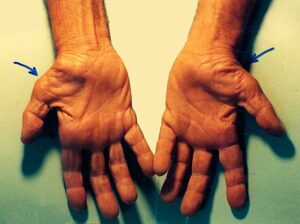In the digital age, where keyboards and screens dominate our daily routines, the prevalence of hand and wrist discomfort is no surprise.
Thoracic outlet syndrome (TOS) and ulnar tunnel syndrome (UTS) are two conditions often misdiagnosed as carpal tunnel syndrome due to overlapping symptoms and anatomical similarities.
These two conditions, thoracic outlet syndrome (TOS) and ulnar tunnel syndrome (UTS) are often misdiagnosed and require a closer examination to ensure proper treatment and relief.
Understanding Two Conditions That Are Often Misdiagnosed As Carpal Tunnel Syndrome – Learn More About Hand Pain!
Contents
- 1 Understanding Two Conditions That Are Often Misdiagnosed As Carpal Tunnel Syndrome – Learn More About Hand Pain!
- 2 Differentiating The Imposters From Carpal Tunnel Syndrome – Ensure Accurate Diagnosis For Effective Treatment!
- 3 Frequently Asked Questions:
- 3.1 1. How can I differentiate between carpal tunnel syndrome and thoracic outlet syndrome?
- 3.2 2. What are the common symptoms of ulnar tunnel syndrome?
- 3.3 3. Are there any specific risk factors for misdiagnosis of these conditions?
- 3.4 4. What are the treatment options for thoracic outlet syndrome and ulnar tunnel syndrome?
- 4 Conclusion:

1. Carpal Tunnel Syndrome Overview:
Before delving into the misdiagnosed conditions, it’s crucial to understand what carpal tunnel syndrome truly entails.
Carpal tunnel syndrome (CTS) occurs when the median nerve, which runs from the forearm into the palm, becomes pressed or squeezed at the wrist. This compression leads to numbness, tingling, weakness, or muscle damage in the hand and fingers.
2. Causes and Risk Factors of CTS:
CTS commonly stems from repetitive hand movements, such as typing or assembly line work, which strain the wrist’s delicate structures.
Additionally, factors like genetics, underlying health conditions (such as diabetes or arthritis), and wrist anatomy can contribute to the development of CTS.
Two Conditions Often Misdiagnosed as Carpal Tunnel Syndrome – Discover the hidden causes of hand pain!
3. Thoracic Outlet Syndrome (TOS):
TOS presents symptoms akin to CTS but originates from a different anatomical location. In thoracic outlet syndrome (TOS), the nerves or blood vessels passing through the thoracic outlet between the collarbone and first rib become compressed.
This compression can result from poor posture, trauma, or anatomical variations, leading to pain, numbness, and weakness in the arm and hand.
Often, individuals with TOS experience symptoms that mimic CTS, leading to misdiagnosis and delayed treatment.
4. Ulnar Tunnel Syndrome (UTS):
While CTS affects the median nerve, ulnar tunnel syndrome (UTS) targets the ulnar nerve, which runs from the neck down the arm and into the hand’s pinky and ring fingers.
Compression of this nerve at the wrist, known as Guyon’s canal, causes symptoms similar to CTS, including numbness, tingling, and weakness in the hand.
Activities that involve repetitive gripping or pressure on the palm, such as cycling or prolonged use of hand tools, can exacerbate UTS symptoms.
Due to the overlap in symptomatology, UTS often goes undetected or misdiagnosed as CTS, delaying appropriate management strategies.
Differentiating The Imposters From Carpal Tunnel Syndrome – Ensure Accurate Diagnosis For Effective Treatment!

1. Diagnostic Approaches:
Distinguishing between CTS and its imposters requires a thorough assessment by a healthcare professional. Diagnostic tests such as electromyography (EMG), nerve conduction studies, and imaging (e.g., MRI) can help pinpoint the exact nerve compression site and differentiate between CTS, TOS, and UTS.
2. Treatment Strategies for CTS, TOS, and UTS:
While CTS, TOS, and UTS share overlapping symptoms, their treatment approaches may vary. For CTS, conservative measures like wrist splinting, ergonomic modifications, and physical therapy are often effective in relieving symptoms.
In severe cases, surgical intervention, such as carpal tunnel release, may be necessary.
Conversely, TOS and UTS may require a multidisciplinary approach, incorporating physical therapy to address posture and muscle imbalances and surgical options to alleviate nerve compression.
Preventing Misdiagnosis and Ensuring Proper Treatment – Advocate for yourself to receive the right care!
3. Educating Healthcare Professionals:
Raising awareness among healthcare professionals about the distinctions between CTS, TOS, and UTS is vital to avoid misdiagnosis.
Educational initiatives, such as continuing education programs, are pivotal in keeping medical practitioners updated on the latest diagnostic criteria and management strategies for these conditions.
By staying informed, healthcare providers can accurately assess symptoms, conduct appropriate diagnostic tests, and initiate timely treatment interventions.
Updated diagnostic guidelines are invaluable tools, enabling clinicians to differentiate between similar presentations and provide tailored care to patients suffering from hand and wrist discomfort.
Overall, prioritizing education and staying abreast of advancements in medical knowledge are essential in ensuring optimal patient outcomes and preventing unnecessary suffering due to misdiagnosis.
4. Empowering Patients with Knowledge:
Empowering patients to voice their concerns and seek additional opinions is crucial in navigating ambiguous diagnoses.
Equipping individuals with knowledge about CTS, TOS, and UTS enables them to make informed decisions about their healthcare journey.
Patients can actively engage in discussions with healthcare providers by fostering a sense of agency, leading to more personalized treatment plans.
Access to resources and information boosts confidence in patients, allowing them to advocate for comprehensive evaluations and explore various treatment options.
Ultimately, encouraging patient involvement promotes collaborative decision-making and enhances overall healthcare outcomes.
Frequently Asked Questions:
1. How can I differentiate between carpal tunnel syndrome and thoracic outlet syndrome?
While both conditions may present with hand and arm symptoms, carpal tunnel syndrome primarily affects the median nerve at the wrist. In contrast, thoracic outlet syndrome involves compression of nerves or blood vessels between the collarbone and first rib. Diagnostic tests such as electromyography (EMG) and nerve conduction studies can help differentiate between the two conditions.
2. What are the common symptoms of ulnar tunnel syndrome?
Ulnar tunnel syndrome (UTS) shares symptoms with carpal tunnel syndrome, including numbness, tingling, and weakness in the hand. However, UTS affects explicitly the ulnar nerve, leading to symptoms in the pinky and ring fingers. Activities that involve repetitive gripping or pressure on the palm can exacerbate UTS symptoms.
3. Are there any specific risk factors for misdiagnosis of these conditions?
Misdiagnosis of thoracic outlet syndrome and ulnar tunnel syndrome as carpal tunnel syndrome can occur due to overlapping symptoms and lack of awareness among healthcare professionals. Additionally, improper diagnostic evaluation or reliance solely on clinical examination without appropriate imaging studies can contribute to misdiagnosis.
4. What are the treatment options for thoracic outlet syndrome and ulnar tunnel syndrome?
Treatment for thoracic outlet syndrome and ulnar tunnel syndrome may include conservative measures such as physical therapy, ergonomic modifications, and lifestyle changes. In some cases, surgical intervention may be necessary to alleviate nerve compression and restore function in the affected hand and arm. Treatment strategies should be tailored to individual patient needs and guided by a healthcare professional.
Conclusion:
CTS isn’t the only cause of hand and wrist discomfort. TOS and UTS share similar symptoms but stem from different areas. Misdiagnosis can prolong suffering, so thorough evaluations and self-advocacy are essential for proper management.
Read:

